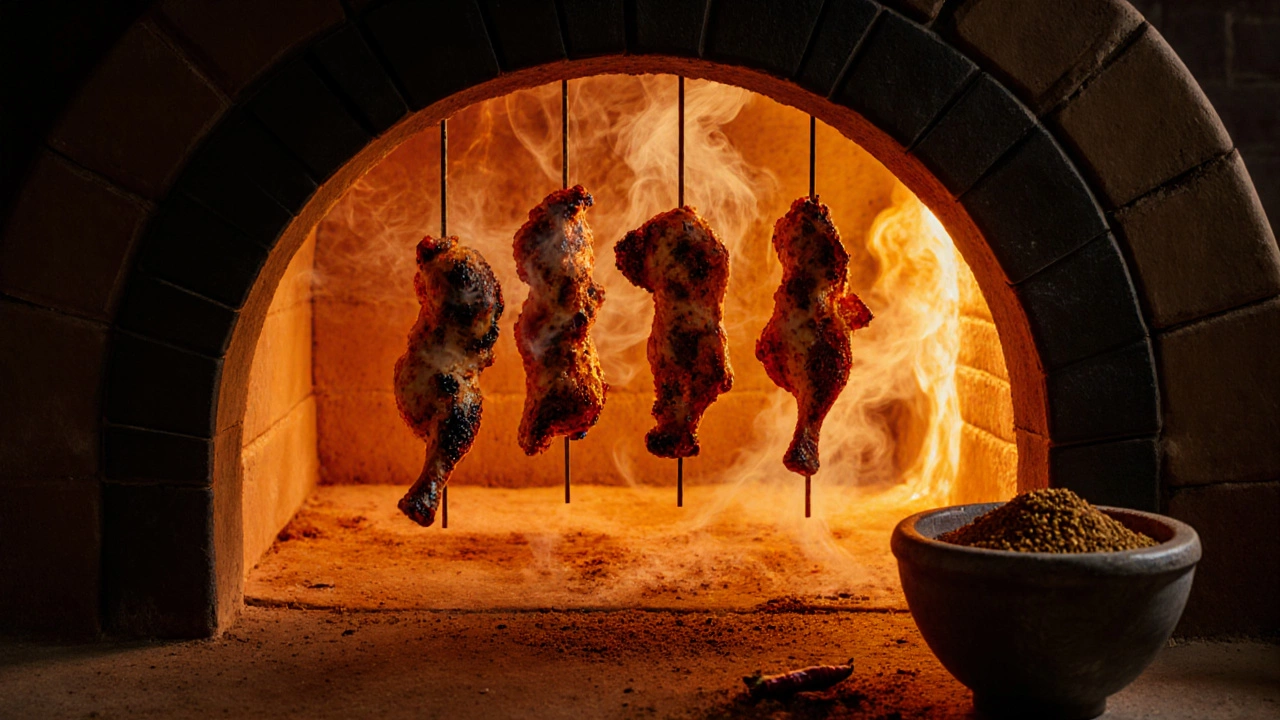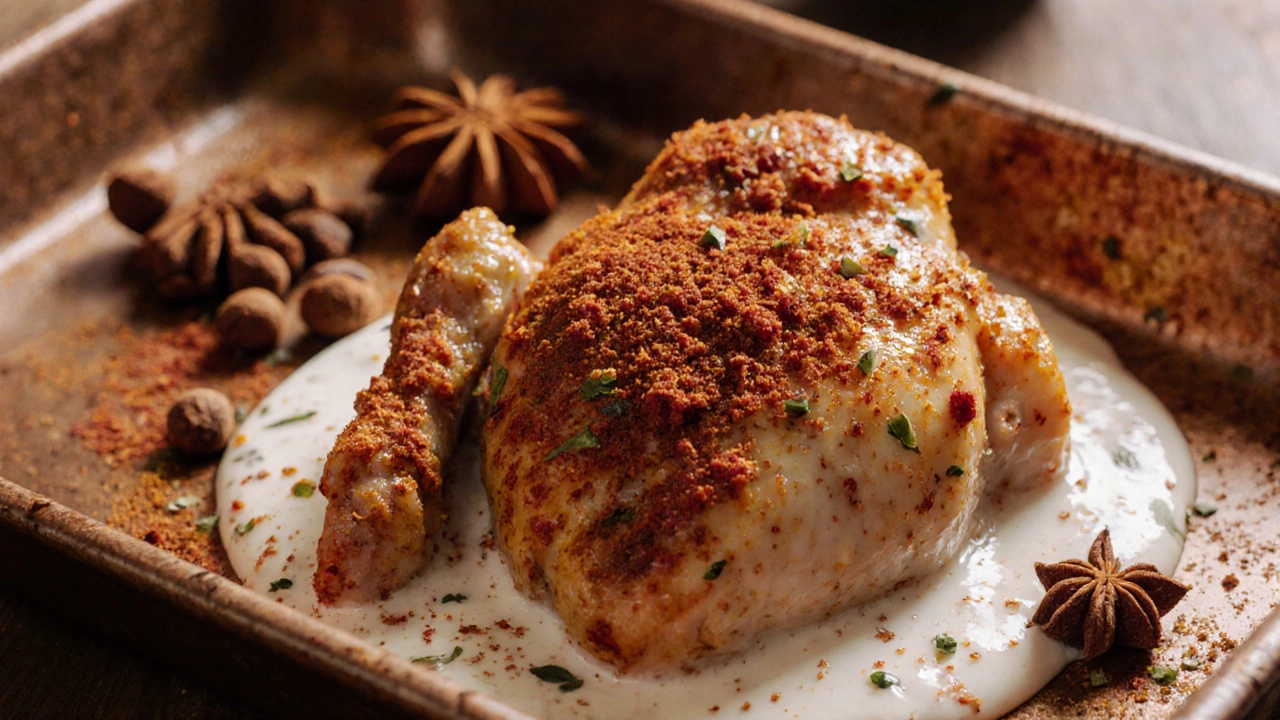
Tandoori Chicken Spice Calculator
Calculate exact spice ratios based on your chicken quantity and type to achieve authentic tandoori flavor, color, and texture as described in the article.
Your Tandoori Spice Mix
Natural deep red color without artificial dyes - key to authentic tandoori appearance
Full-fat yogurt for natural tenderizing and spice adherence
Balances flavor with citrusy notes
Provides warmth without heat
Subtle bitterness that balances sweetness and smokiness
Tandoori chicken isn’t just spicy. It’s not just colorful. It’s not even just about the smoky char. What makes it unforgettable is the perfect storm of technique, tradition, and chemistry that turns simple chicken into something that sticks to your memory long after the last bite.
The Magic of the Tandoor
You can’t talk about tandoori chicken without talking about the tandoor. This clay oven, heated to over 480°C (900°F), isn’t just a cooking tool-it’s the soul of the dish. The walls of the tandoor absorb and radiate heat evenly, creating a dry, intense environment that sears the outside of the chicken in seconds while locking in moisture inside. That’s why the meat stays juicy even when it looks charred and crispy on the outside.Unlike grilling over coals, where flames lick and flare unpredictably, the tandoor’s radiant heat cooks from all sides. The chicken hangs on skewers, rotating slowly, so every inch gets exposed to the same intense heat. No part is overcooked. No part is raw. Just perfectly done.
The Yogurt Marinade That Changes Everything
The secret isn’t in the spices alone-it’s in the base. Tandoori chicken is marinated for at least 12 hours, sometimes up to 48, in thick, full-fat yogurt. That’s not just for flavor. Yogurt is acidic, and that acidity gently breaks down the muscle fibers in the chicken. It’s like a natural tenderizer. But unlike lemon juice or vinegar, which can make meat mushy if left too long, yogurt works slowly and evenly.Yogurt also carries the spices deep into the meat. It’s sticky, so it clings. And as the chicken cooks, the yogurt dries out and caramelizes, forming a crust that’s both crunchy and flavorful. You get a texture contrast that’s hard to replicate: crisp outside, tender inside, with every bite tasting like it’s been kissed by fire and spice.
The Spice Blend That Tells a Story
The red color? That’s not food dye. It’s Kashmiri chili powder-mild in heat but rich in color. It’s mixed with cumin, coriander, garam masala, garlic, ginger, and a pinch of fenugreek. Each spice has a role. Cumin adds earthiness. Coriander brings citrusy brightness. Garam masala gives warmth without heat. Fenugreek? That’s the hidden note-it adds a subtle bitterness that balances the sweetness of the yogurt and the smokiness of the oven.What most home cooks miss is the order of mixing. Spices are toasted dry first, then ground fresh. Pre-ground spices lose their oils within weeks. Freshly ground? They explode with aroma the moment they hit the yogurt. That’s why restaurant tandoori chicken often tastes deeper and more layered than what you get at home.

The Science of the Red Color
You’ve probably seen tandoori chicken in supermarkets with bright red sauce. That’s not authentic. Real tandoori gets its color from Kashmiri chilies and sometimes a touch of beetroot or tomato paste. The heat from the tandoor causes the natural pigments in the spices to oxidize and deepen. That’s why the chicken looks darker when it comes out of the oven than when it went in.Some places use artificial coloring to make it look more ‘Indian’ to tourists. But if you’ve eaten it in Punjab or Delhi, you know the color should be a deep rust, not neon. The real thing doesn’t need to shout. It just needs to taste right.
Why It Works Better Than Other Grilled Chicken
Compare tandoori chicken to a typical grilled chicken breast. The latter is often dry, bland, and lacks depth. Why? Because it’s usually marinated for minutes, not hours. It’s cooked on a flat grill with direct flame, which chars unevenly. And the spices? Often just salt, pepper, and paprika.Tandoori chicken is the opposite. The yogurt marinade isn’t optional-it’s essential. The spice blend isn’t generic-it’s balanced. The cooking method isn’t convenient-it’s intentional. You can’t rush tandoori chicken. And that’s why it’s so good. It rewards patience.

How to Get Close at Home
You don’t need a tandoor to make great tandoori chicken. But you do need to mimic its environment. Preheat your oven to its highest setting-250°C (480°F)-with a baking sheet or cast iron skillet inside. Place the marinated chicken on a wire rack over a tray so air circulates around it. Broil for 5-7 minutes per side until the edges blacken slightly.For extra smoke flavor, throw a soaked cedar plank or a handful of wood chips into a foil packet and place it on the bottom of the oven. Don’t overdo it-just a hint of smoke will do. The goal isn’t to recreate the tandoor exactly. It’s to get as close as possible to that deep, charred, juicy, spiced experience.
What to Serve With It
Tandoori chicken doesn’t need much. A simple onion salad with lime juice and a pinch of salt cuts through the richness. Fresh coriander leaves add brightness. But the real partner? Naan. Warm, pillowy, slightly charred naan, brushed with ghee, is the perfect vehicle to soak up the juices. You can also serve it with mint chutney-cool, tangy, and fresh. The contrast between the hot, smoky chicken and the cool chutney is what makes the meal feel complete.Common Mistakes People Make
- Using low-fat yogurt-it won’t cling or caramelize properly.
- Marinating for less than 6 hours-you won’t get the depth of flavor or tenderness.
- Skipping the fresh spices-pre-ground cumin won’t give you the same punch.
- Overcooking in the oven-chicken should still be slightly pink in the center when you take it out. It continues to cook from residual heat.
- Using too much food coloring-real tandoori chicken is naturally colored. If it looks like a firework, it’s not authentic.
There’s no shortcut to great tandoori chicken. But once you get the balance right-yogurt, spice, heat, time-it becomes more than a dish. It becomes a ritual. And that’s why it’s so good.
Why is tandoori chicken red?
The red color comes naturally from Kashmiri chili powder, which is mild but deeply pigmented. Sometimes a bit of tomato paste or beetroot is added for extra color. Artificial red dye is common in restaurants catering to tourists, but authentic versions rely on natural spices and the caramelization that happens in the tandoor.
Can I make tandoori chicken without a tandoor oven?
Yes. Preheat your oven to its highest setting (250°C/480°F) with a baking sheet inside. Place marinated chicken on a wire rack over a tray and broil for 5-7 minutes per side. For smoke flavor, add a foil packet with soaked wood chips or a cedar plank. The key is high heat and air circulation to mimic the tandoor’s dry, radiant cooking.
How long should I marinate tandoori chicken?
At least 12 hours, but 24-48 hours is ideal. The yogurt needs time to break down the proteins and carry the spices deep into the meat. Shorter marination times result in less tender chicken and weaker flavor penetration.
What’s the best cut of chicken for tandoori?
Bone-in, skinless chicken thighs are best. They have more fat and connective tissue, which keeps them juicy under high heat. Chicken breasts can dry out easily. If you use breast meat, marinate longer and cook at a slightly lower temperature.
Is tandoori chicken healthy?
Yes, compared to fried chicken. It’s grilled, not fried, and the marinade uses natural ingredients-yogurt, spices, garlic, ginger. It’s high in protein and low in carbs. Just watch added sugars in store-bought marinades. Making it at home gives you full control over ingredients.